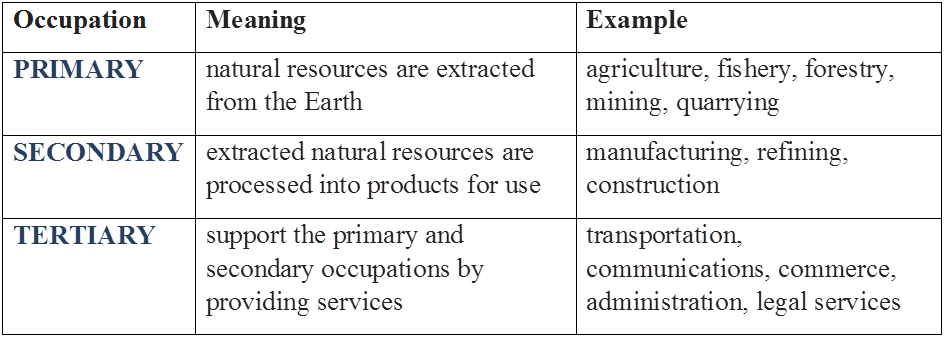- Books Name
- Learn with me Social Science Book
- Publication
- Learn with me publication
- Course
- CBSE Class 9
- Subject
- Social Science
Occupational Structure
Occupational structure referred to as the distribution population according to various types of occupation.
Economically active population percentage is an important index of development. There is a large variety of occupation in the country. The occupations are usually categorized into
• Primary
• secondary
• tertiary occupations.

Primary occupations are those in which natural resources are extracted from the Earth. These include agriculture, fishery, forestry, mining, quarrying, etc.
Secondary occupations are those in which the extracted natural resources are processed into products for use. These include manufacturing, refining, construction, etc.
Tertiary occupations are those which support the primary and secondary occupations by providing services. This transportation, communications, commerce, administration, legal services, etc.
The pattern of the Working Population
The proportion of people working in different activities vary in developed and developing countries. The developing countries have more of their population working in primary occupations, whereas the developed nations have more of their population working in secondary and tertiary occupations.
In India, half of the population is engaged in agriculture alone. However, due to industrialisation and urbanisation in recent times, there has occurred a significant shift towards secondary and tertiary occupations which earlier stood about 13% and 20%, respectively.
Health
Health is an important component of population composition. It affects its development significantly. Due to the sustained efforts of government, healthcare programmes, life expectancy at birth has improved from 36.7 years in 1951 to 64.7 years in 2011.
The death rate has declined from 25 per 1000 persons in 1951 to 7.2 in 2011. However, healthcare and nutrition are still major issues. Malnutrition in children afflicts a large percentage of the population.
Availability of safe drinking -water and proper sanitation are major problems in rural areas and need urgent action. Only one-third of the rural population has these basic amenities. The level of nutrition and per capital calorie consumption is much below the recommended level. This can be reduced by appropriate policy on population.
Adolescent Population
Adolescents are population aged from 10 to 19 years. They currently comprise about 20% of India’s population and are an important future resource for the country.
Their nutritional requirements are more than that of either adults or younger children, but it our country the diet available for them is usually inadequate for their requirements, which leads to deficiency and stunted growth. Many adolescent girls suffer from anaemia and they must be made aware of their requirements through better education and literacy they confront.
National Population Policy
Government of India initiated its first Family Planning Programme in 1952. This, promoted responsible and planned parenthood on a voluntary basis. In the year 2000, the government formulated the National Population Policy (NPP 2000), which had the following major objectives
• Providing a policy framework for imparting free and compulsory school education up to 14 years of age.
• Reducing infant mortality rate to below 30 per 1000 live births.
• Achieving universal immunization of children against all vaccine-preventable diseases.
• Promoting delayed marriage for girls.
• Making family welfare a people-centred programme.
NPP 2000 and Adolescents
National Population Policy (NPP) 2000 identified adolescents as one of the major sections of the population that need greater attention.
NPP 2000 put greater emphasis on the important needs of adolescents including protection from unwanted pregnancies,’ Sexually Transmitted Diseases (STDs) and risks of unprotected sex. It focussed on programmes that aim towards encouraging delayed marriage and childbearing, education of adolescents, providing food supplements and nutritional services, etc.
Summary points
• The age composition of a population refers to the number of people in different age groups in a country.
• The population of a nation is generally grouped into three broad categories, namely children (generally below 15 years), working age (15 – 59) years) and aged (above 59 years).
• Sex ratio is defined as the number of females per thousand males in the population.
• The sex ratio in India has always remained unfavourable to females.
• Kerala has the highest sex ratio whereas Delhi and Haryana are amongst lowest.
• A person of seven years of age or above who is able to read and write with a certain understanding is called a literate.
• Males have more literacy than females.
• The distribution of the population according to different types of occupation is referred to as the occupational structure.
• Primary activities include agriculture, animal husbandry, forestry, fishing, mining and quarrying etc. Secondary activities include manufacturing industry, building and construction work etc. Tertiary activities include transport, communications, commerce, administration and other services.
• Sustained efforts of government programmes have registered significant improvements in the health conditions of the Indian population. Death rate is considerably reduced.
• It is a matter of concern that the per capita calorie consumption is much below the recommended level in India.
• Adolescent population constitutes one fifth of the total population of India.
• Adolescents in India face the problem of malnutrition that can be dealt with by spreading awareness, literacy and education among them.
• The Family Welfare Programme has sought to promote responsible and planned parenthood on a voluntary basis.
• National Population Policy 2000 aims at improving conditions of adolescents, aiming at encourages delayed marriages and child bearing, educating about risks of unprotected sex and provisions for nutritional need.

 Learn with me publication
Learn with me publication
